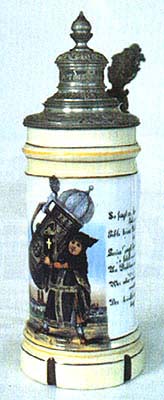
by Jack G. Lowenstein
 |
During the early porcelain period, painting was done by “Hausmaler,” artists who worked in home studios decorating blank bodies furnished by the porcelain factories. These Hausmaler-decorated porcelain steins and tankards are the most sought-after and valuable ones today.
Transfer printing was developed in the second half of the 19th century. A picture was printed in glaze colors on tissue paper which was then positioned on the stein body. Firing would burn away the paper and at the same time fix the glaze colors into the porcelain surface. A slightly different technique, developed originally in England, was the decal, where the printed image was transferred to the beer stein, while the backing paper was lifted off prior to firing. In either case, mass-produced prints took the place of laborious and expensive hand-painting to produce low-cost drinking vessels for the populace.
After the reunification of Germany in 1871, Munich became the uncontested art center of Germany and the symbol of Munich, the Munich Child (“Münchner Kindl”), became a favorite decor for everything from calendars to dinnerware to wall plaques to, of course, beer steins. The Child originated from the monk figure shown in early Munich coats-of-arms, since Munich was founded by monks who banded together on the banks of the Isar River (Mönchen = München = Munich). Between the years 1871 and 1914, countless thousands of beer steins were produced with the Munich Child as the main motif. Obviously every visitor to Munich had to bring home a Munich Child beer stein as a souvenir of this great Bavarian city!
Of the several Bavarian porcelain factories, the state-owned Nymphenburg Porcelain Factory is certainly the best known. But many others in the vicinity of Munich turned out porcelain beer steins as well, and most of the so-called souvenir steins were made in these nameless factories.
__________
*Reprinted by permission from All About Beer Magazine, Vol. 11, No. 6, December 1990.